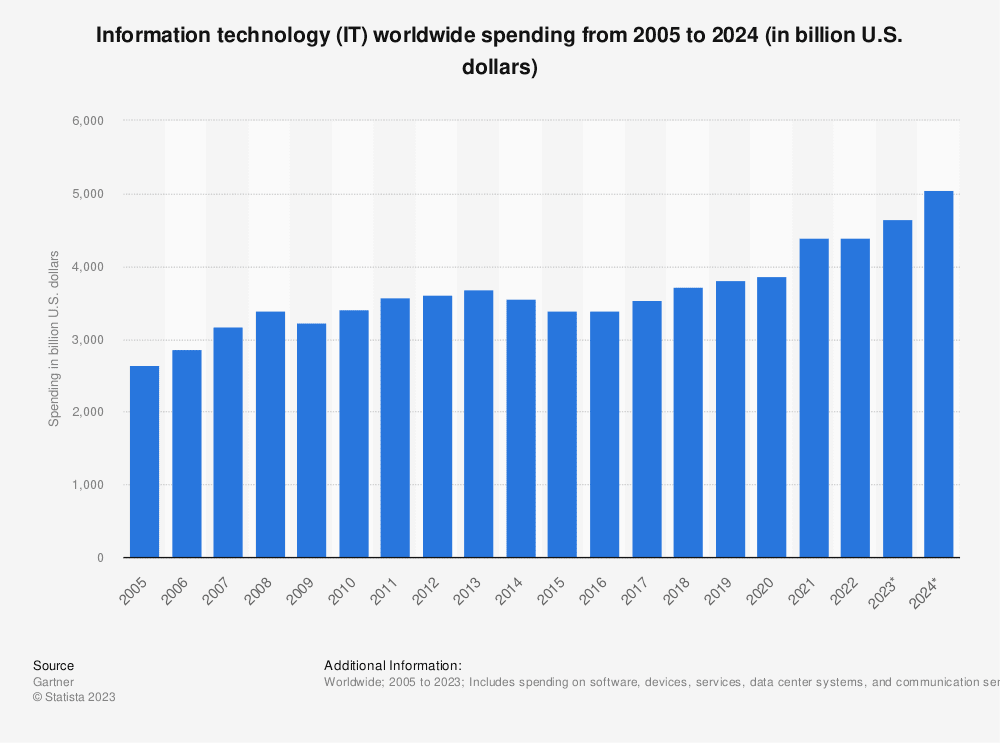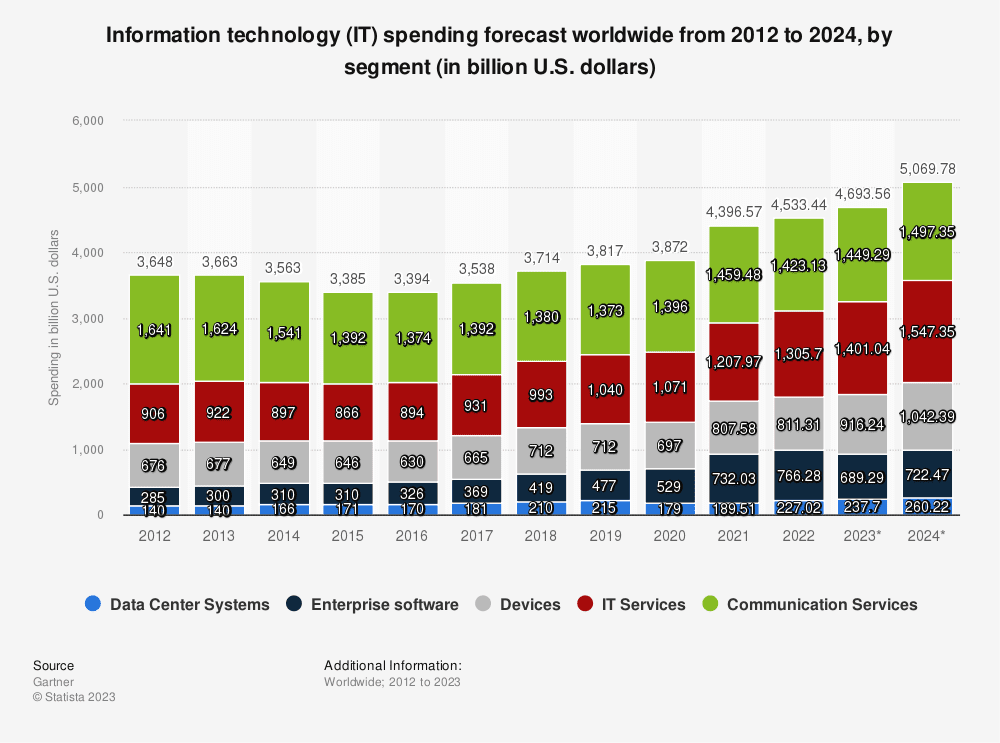Olive’s Top 3 Enterprise Tech Trends for 2024
Setting the Stage for 2024
In the rhythm of enterprise technology, where decisions orchestrate the future, 2024 stands poised as the headlining act, ready to take center stage. The enterprise tech landscape is in the midst of a monumental upheaval, reflected in a surge in global IT spending from 4.7 trillion to an impressive 5.1 trillion U.S. dollars. This financial commitment signifies a steadfast dedication to technology as the driving force for profound business transformation.
The Spending Surge and Strategic Allocation
At the heart of this surge, IT services and communication services take the lead, transcending their roles as mere cost centers. They emerge as integral components, optimizing operational efficiency, with unified communication services playing a pivotal role in virtual connectivity and heightened productivity.

Yet, the story extends beyond financial figures. The increased investment mirrors a broader dedication to digital transformation initiatives. These investments are geared towards streamlining processes, harnessing data-driven insights, and fortifying organizational agility in the face of dynamic market conditions.

The surge in IT spending is more than financial commitment; it symbolizes the intentional integration of technology as a catalyst for innovation and growth. In 2024, enterprises aren’t merely adapting to the digital era—they’re actively leveraging technology to redefine industry norms and reshape operational paradigms. The emphasis is not just on staying competitive; it’s on leading the charge in an era where technology is the cornerstone of business evolution.
Sourcing Tech Beyond the Trends
In the anticipation of 2024, we’ve been keeping up with predictions from industry giants Gartner, Forbes, CIO.com, CIODive, Info-Tech Research Group and other strategic foresight from enterprise technology thought leaders.
Here, we explore what they’re saying, looked at a mix of common ground and unique viewpoints and pulled out the top 3 Enterprise Tech trends that we think will weave the tale of the year ahead. However, we always advise caution when sourcing solutions. It’s easy to fall into the trap of buying the “newest” or “best” to be first, but, it’s crucial for businesses to go beyond the hype, the “magic,” and the biased reviews and perform a thorough technology evaluation in order to source technologies and vendors that will meet the unique needs of the business. By doing so, companies can make more informed decisions, unlock innovative possibilities, and drive true transformation.
1. Generative AI in the Enterprise
Generative AI and Everyday Automation
In 2024, there will be a projected shift in the adoption of generative AI, with the expectation that certain software vendors will recognize the limited impact of their AI implementations. Matthew Miller, a Senior Research Analyst at G2, anticipates that less effective AI features will fade away, while those providing tangible benefits will endure. Despite the prevalence of generative AI features across numerous software categories, G2’s data reveals that users have not experienced transformative outcomes. Miller emphasizes that vendors are likely to scale back on gimmicky features that don’t deliver meaningful business impact, leading to a potential drop in AI features across various categories as businesses seek practical solutions to address their specific needs.
In envisioning the future landscape of enterprise technology, Bernard Marr, a renowned tech visionary, paints a vivid picture of Generative AI’s ascendance to center stage, undergoing a transformative evolution into a super-smart assistant. This foresight aligns seamlessly with Gartner’s strategic emphasis on the proliferation of AI-driven business models and the democratization of Generative AI.
Marr’s vision propels Generative AI beyond its current capabilities, positioning it as a versatile and intelligent aide that goes beyond conventional automation. This transformation implies a shift from mere task execution to a more nuanced role, where Generative AI becomes an active collaborator, enhancing efficiency, productivity, and fostering heightened human creativity.
Parallelly, Gartner’s strategic insights reinforce this narrative by underlining the strategic importance of AI-driven business models. The emphasis on democratized Generative AI signifies a broader accessibility, breaking down barriers to entry and empowering a larger audience to harness the capabilities of this advanced technology. This democratization aligns with the idea that Generative AI, once confined to tech elites, will become a pervasive and integral tool for diverse industries, fostering innovation and reshaping operational paradigms. Together, Marr and Gartner articulate a shared vision of Generative AI not only as a technological advancement but as a catalytic force driving significant shifts in how businesses operate and innovate.
AI-Augmented Development and Responsible AI
Gartner introduces challenges in AI-augmented development, providing a counterpoint to Marr’s seamless narrative. Additionally, Gartner’s call for urgency in AI security and privacy measures contrasts with Marr’s focus on responsible AI, indicating a nuanced perspective on ethical considerations in AI development and deployment.
CIO Dive reports the same. Trends anticipated for Chief Information Officers (CIOs) in 2024 underscore the increasing importance of artificial intelligence (AI) and machine learning (ML) as essential tools for businesses. As per findings from the CIO Survey Report, a substantial portion of CIOs is gearing up to integrate AI and machine learning technologies into their operations. Specifically, 65% of surveyed CIOs have expressed their active commitment to investing in projects centered around AI and machine learning. This points to a strategic shift within the CIO landscape, recognizing the transformative potential of these technologies in shaping the future of business operations.
GenAI Faces Regulatory Scrutiny
Regulators will intensify scrutiny of generative AI, with ongoing investigations and lawsuits. The European Data Protection Board and the US Federal Trade Commission will coordinate enforcement actions against ChatGPT. While large entities like OpenAI can defend themselves, third-party apps running on ChatGPT face regulatory risks without the resources and expertise to mitigate them effectively.
Navigating Uncertainty with GenAI
In the backdrop of tense global events, including high-stakes political elections, economic uncertainties, and societal tensions, the risk lies in waiting by the shore. Generative AI becomes the fulcrum for businesses to enhance, empower, and engage both employees and customers. Waiting for others to lead is the greatest risk. Forrester recommends embracing the missteps, thinking big, and welcoming the transformative era of 2024.
The recent upheaval at OpenAI, particularly the events surrounding Ilya Sutskever’s attempt to overthrow Sam Altman, underscores the volatility within the AI landscape. Navigating this uncertainty requires careful vendor selection and strategic software sourcing, aligning with the transformative era of 2024 and embracing calculated risk, resilience, and sustainable investments as a compass for navigating the dynamic landscape of enterprise technology.
2. Phygital Convergence: Blending the Physical and Digital Realms
Gartner, Marr, and the anticipation of Generative AI evolving into a super-smart assistant find resonance in Gartner’s emphasis on AI-driven business models. Delving deeper into the Phygital realm, both Marr and Gartner recognize the transformative potential of blurring the lines between the physical and digital realms in the enterprise.
Understanding Phygital Convergence
In a phygital world, the online and offline channels are no longer substitutes but good complementaries. Physical experiences can be enhanced with the convenience and excess of information the internet holds, whereas digital experiences can be enhanced with human connections or physical enhancements. Through blending the physical and digital worlds, retailers can streamline and personalize their customer journey and ultimately create immersive, immediate, and interactive customer experiences.
Accenture’s 2023 Tech Vision
Accenture’s 2023 Tech Vision heralds the age of “Phygital” convergence, where atoms meet bits in a transformative way. CIOs are urged to prioritize digitalizing the physical world for competitiveness and addressing growing complexity.
In the realm of technology trends for 2023, a pivotal emphasis is placed on prioritizing the development of infrastructure in key domains: automation, trust, data, and science. This directive challenges businesses to transcend mere buzzwords and actively invest in tangible infrastructure with a real-world impact. A notable evolution in this landscape is witnessed in the trajectory of digital twins, moving beyond isolated components to encompass entire systems. This evolution empowers businesses to exercise granular control over their manufacturing plants and supply chains, fostering efficiency and personalization by dynamically adapting to consumption patterns and manufacturing capabilities.
Examples of Phygital Convergence
Several companies have successfully implemented phygital convergence to enhance customer interactions and provide innovative, personalized services:
- Kum & Go: The company has integrated a phygital experience by allowing customers to choose their pump location, apply rewards, and pay for gas through their app, streamlining contactless gas payments
- Starbucks: Through its app, Starbucks provides personalized recommendations and easy ordering, allowing customers to order online and seamlessly pick up at the restaurant while earning rewards
- Amazon Go: Amazon’s cashier-less stores offer a completely phygital shopping experience using AI and computer vision technology to track purchases and charge customers’ accounts automatically.
These examples illustrate how companies are leveraging phygital convergence to redefine customer experiences and create a seamless blend of physical and digital interactions.
Phygital convergence presents a transformative opportunity for businesses to create immersive, immediate, and interactive customer experiences by seamlessly blending the physical and digital worlds.
3. Industry Cloud Platforms
Industry cloud platforms (ICPs) are emerging as a pivotal trend in information technology, addressing the unique needs of vertical industry segments underserved by generic solutions.
These platforms seamlessly blend software, platform, and infrastructure services to offer tailored solutions for various industries. Gregor Petri, VP Analyst at Gartner, ICPs transform a cloud platform into a business platform, acting as modular, composable platforms supported by a catalog of industry-specific packaged business capabilities.
Gartner’s recent survey reveals a growing adoption of industry cloud platforms, with nearly 39% of North America- and Europe-based enterprises having initiated adoption, and an additional 14% in pilot phases. An additional 17% are considering deployment by 2026. This trend is expected to accelerate, with Gartner predicting that by 2027, over 70% of enterprises will leverage industry cloud platforms to expedite their business initiatives, marking a significant increase from less than 15% in 2023.
Industry cloud platforms operate by combining underlying Software as a Service (SaaS), Platform as a Service (PaaS), and Infrastructure as a Service (IaaS) with innovative technologies. They enable rapid adaptation of processes and applications, fostering a modular and composable approach. The holistic yet modular nature of these platforms facilitates the swift transfer of technical and business innovations between industries.
In contrast to community clouds, industry clouds distinguish themselves by offering the full set of industry-relevant capabilities of the underlying platform, avoiding the need for separate maintenance. The transformative potential of industry cloud platforms is evident in their ability to create value for companies by providing adaptable and relevant industry solutions, significantly accelerating cloud adoption.
Gregor Petri suggests that to reach their full potential, industry clouds must evolve into ecosystem clouds. Enterprises can harness these ecosystems by engaging in shared (business) processes like procurement, distribution, payment processing, and potentially even R&D and innovation. The success of industry cloud platforms relies on broad stakeholder involvement from both IT and line-of-business organizations. This shift is not merely about technology but a strategic move towards aligning technology innovation with business transformation.
The Era of the Generative Enterprise: A Common Thread
These thought leaders have introduced the concept of the Generative Enterprise, emphasizing AI’s disruptive impact and providing a roadmap for seizing opportunities and mitigating risks.
As we delve into the overlapping and contrasting predictions for 2024, a symphony of tech trends emerges, guiding us toward a future where technology isn’t just a tool but a transformative force. The era of The Generative Enterprise beckons, urging strategic software sourcing to unlock new opportunities and navigate the dynamic landscape of 2024.
In this tech-forward future, let the calculated risk, resilience, and sustainable investments be our compass, steering us through the transformative waves of enterprise technology.
As we embrace the era of The Generative Enterprise, let these tech trends be the compass for strategic software sourcing, unlocking new opportunities and navigating the dynamic landscape of 2024.





